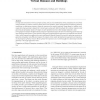Free Online Productivity Tools
i2Speak
i2Symbol
i2OCR
iTex2Img
iWeb2Print
iWeb2Shot
i2Type
iPdf2Split
iPdf2Merge
i2Bopomofo
i2Arabic
i2Style
i2Image
i2PDF
iLatex2Rtf
Sci2ools
CGF
2005
2005
Perceptual Evaluation of Impostor Representations for Virtual Humans and Buildings
In large-scale simulations involving complex scenes, such as cities inhabited by crowds, simplifications are almost always necessary to achieve interactive frame-rates. Level of Detail (LOD) techniques such as reducing geometric complexity, or substituting impostor images for geometry, are usually employed. Image-based or impostor techniques have been gaining in popularity in recent years, along with hybrid methods that combine impostors and geometry, but perceptual issues with respect to such representations have been largely neglected to date. In this paper we evaluate the effectiveness of impostor representations for the real-time rendering and animation of static buildings and dynamic virtual humans. Using sets of psychophysical experiments, we establish some thresholds at which impostors are effective for static and dynamic objects, along with criteria for selecting transitions to geometry and update rates. We also compare the impact of two model representations (geometry and imp...
| Added | 15 Dec 2010 |
| Updated | 15 Dec 2010 |
| Type | Journal |
| Year | 2005 |
| Where | CGF |
| Authors | John Hamill, Rachel McDonnell, Simon Dobbyn, Carol O'Sullivan |
Comments (0)

